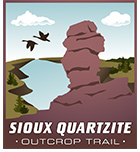Glossary
Petrogylphs
Also call rock engravings, petrogylphs are pictogram and logogram images created by removing part of a rock surface by incising, picking, carving, and abrading.
Coteau des Prairie
French for “Hills of the Prairie”, the Coteau is eastern South Dakota’s and south western Minnesota’s most distinctive land formation. (see map to the right) It is a “flat iron” shaped upper highland plateau about 200 miles long and 70 miles wide at its maximum width. Elevation’s reach over 2,000 feet above sea level in the northern part. The map to the right shows the Coteau and indicates where quartzite is bedrock. The Coteau is blanketed by thick glacial deposits. After a series of earlier glaciers, the Late Wisconsin ice sheet split as it advanced around the tip of the Coteau. The western branch is called the James Lobe and the eastern branch the Des Moines Lobe. Torrid glacial melt water eroded numerous gorges in the quartzite formation. The Late Wisconsin receded 10,000 – 12,000 years ago.
Ice Ages
When George Catlin (1836) and Joseph Nicollet (1838) visited the Pipestone Quarry located on top of the Coteau des Prairie, the area was scattered with rocks called “erratics”, their origin unknown. (Three huge rocks called the Maidens were at the quarry.) It would be several years after their visits that the theory of continental ice sheets would be widely accepted as proposed by Louis Agassiz.
The US-Dakota Conflict
Sometimes called the Dakota Uprising; the Dakota Sioux of Minnesota (Santee Sioux) waged war on the white residents along the Minnesota River Valley and Eastern Sioux Quartzite Country. The conflict started on August 18, 1862 and is a “stunning” and somewhat obscure story. Before the conflict could be brought under control, at least 450 white settlers and soldiers including Philander Prescott were killed and unaccountable Indians. Prescott was the first white man to visit the Pipestone Quarry and the Falls (1832) and write about it. The Dakota’s failed effort was lead by Little Crow who is buried at Flandreau, SD.
The result of the failed uprising was a disaster for the Dakota Sioux. Besides thirty eight men being hanged on December 26, 1862 in the largest mass execution in American history, almost all of the remaining Sioux, Christian or not, were removed from Minnesota and were exiled to western Sioux Quartzite Country, a barren place called Crow Creek along the Missouri River. The Missionaries accompanied them, including the families of Williamson and Riggs.
To appease returning frightened Dakota Territory settlers, military forts were built at Sioux Falls called Fort Dakota, and at Fort James, south of current Mitchell, SD. A military reservation was also established around Fort Dakota. Fort Dakota was constructed partially of Sioux Quartzite while Fort James was made totally of quartzite stone. Fort James may be America’s only western military fort made entirely of stone.
Geologic Time
- Earth’s age: 4.5 – 4.7 billion years old
- Sioux Quartzite: 1.6-1.7 billion years old
- Dinosaurs: 251 million years ago
- Mammals: 65.5 million years ago
- Human first primitive Ancestors: 4 -6 million years ago
- Ice age (Pleistocene Epoch): 2.6 million – 10,000 years ago
